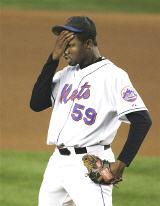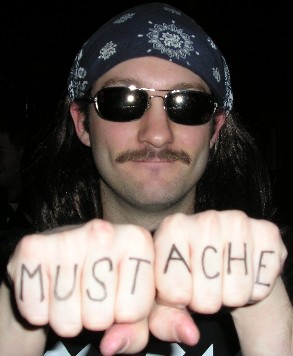
I don’t know if you remember
Game 5 of the NLCS, but I’d said
earlier that it looked to me like the Cardinals hitters had made an adjustment to Glavine and were no longer getting fooled like they were in
Game 1; meanwhile, the Mets bats continued to slumber against Weaver. This got me thinking about the different types of pitchers that Weaver and Glavine are. Jeff Weaver is a guy who’s always had pretty good stuff, but hasn’t ever quite been able to put it all together (until the NLCS, apparently); while Titan Tom Glavine is probably the very definition of a crafty lefty, getting guys out not with blazing fastballs or knee-buckling curves, but with location and deception.
Anyway, I thought that Glavine might be at a disadvantage going into Game 5, because he’d be facing a lineup twice within the space of a week. Of course, Weaver would also be facing the same lineup twice in a row (and a pretty good lineup, at that). But I thought that a guy with good velocity and a good slider would be at less of a disadvantage than a guy who, in order to get guys out, has to fool them.
Most people think that, as the game goes on, the advantage shifts more and more to the hitters. Getting guys out that third or fourth time through the order is a lot harder than the first, because they know what to expect -- just ask
John Maine. I wondered if there might be some of that carry-over effect between starts, when a pitcher is facing the same team in back-to-back starts.
So, I went through
David Pinto’s awesome
day-by-day database for Tom Glavine and Jeff Weaver and took a look at how they fared in games when facing the same team in back-to-back starts, comparing the first start against the second. It turns out that Glavine’s done it 54 times in his career, Weaver 30. For example, Tom Glavine started against the Expos in Montreal on May 22nd of 2002; then faced them again five days later in Atlanta on the 27th. How did he do that second time around, compared to the first?

Here are Glavine’s numbers in those 54 back-to-back starts, comparing the first start against a team with his second start; and, for comparison’s sake, his career numbers. Looking at his
peripherals, there doesn’t appear to be an appreciable difference between his career numbers, in either his first start in a back-to-back series, or his second. Maybe a slightly lower strikeout rate in that second start, but his ERA, walks per nine, home run rate, and K/BB ratio are pretty much the same.
But then it occurred to me, maybe Glavine’s career numbers aren’t that instructive – Tommy came up in freaking 1987, twenty years ago – and his pitching style has changed significantly as he’s gotten older. I’m more interested in how he’s pitched since becoming a Crafty Old Lefty™, say the last five years or so, after he’s maybe lost a little zip on the ol’ fastball.

OK. Here are Tommy Glavine’s numbers from back-to-back starts against the same team from 2001 to 2006. Why 2001? That’s six years. Why not start in 2002 and use a nice, even five years? I dunno, I can’t remember – I started doing this like two weeks ago. But whatever. You can see that Tommy’s peripheral numbers are significantly crappier in those second starts, over the last six years. His ERA goes up, his strikeout rate drops by almost two per game, his homerun rate goes up 50%, and his strikeout-to-walk ratio drops.

Now, take a look at the same numbers for Jeff Weaver over the same period. Done? They look, eh . . . basically the same. His strikeout rate drops a little, but not a whole lot. Everything else stays pretty much exactly the same; and that’s been pretty much true over his whole career (which admittedly only goes back two more years, to 1999). Go ahead and look at his career numbers, too.

So what does this tell us? Well, I’m not sure. None of these numbers are ballpark adjusted, and of course I don’t think you should draw too many conclusions from such a small number of games. But . . .
It’s an old baseball cliché that speed never goes in a slump. Obviously, this isn’t literally true; if it were, Jose Reyes would bat 1.000. I think what the old saw is getting at, though, is that a player’s speed can help him beat out hits even when he’s not actually swinging the bat very well. Similarly, a pitcher’s raw stuff can help him out in the same way – a great curveball might be impossible to hit, even when a batter knows it’s coming.









